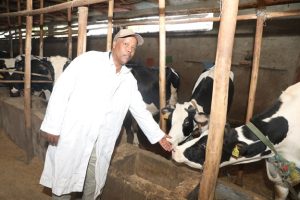Ethiopia is one of the developing countries of the world that largely depend on agriculture as a main stay of majority of its population. Yet due to the fact that the practice of agriculture in the country lacks technological advancement, the country still has to fight to ensure food security.
Among the technologies recommended to address food security through improving agricultural productivity is biotechnology. It is an all rounded technological solution that can help increase productivity, ensure quality as well as alleviate problems related to post harvest loss.
Biotechnology is working to solve these problems by producing plants that resist pests and disease, a major cause of crop damage in the developing world. Biotech corn, which is already widely used in the United States, produces its own protection against the corn borer. Research is under way on sweet potatoes that produce their own protection against SPFMV, as well as beans, cassava and other staple foods with enhanced natural tolerance to diseases, pests, and physical stresses. In 1997, the World Bank Consultative Group on International Agricultural Research estimated that biotechnology could help improve world food production by up to 25 percent.
Biotechnology is also helping to develop more nutritious strains of staple crops. Researchers have been working to develop varieties of cassava that more efficiently absorb trace metals and micronutrients from the soil, have enhanced starch quality and contain more beta-carotene and other beneficial vitamins and minerals. A strain of “golden rice” that packs more and iron and beta carotene, a precursor of Vitamin A, could be on the world market within a few years – helping the more than 100 million children worldwide who suffer from vitamin A deficiency, the developing world’s leading cause of blindness, as well as some 400 million women of childbearing age who are iron-deficient, placing their babies at risk of physical and mental retardation, premature births and natal mortality.
Biotechnology could well help to prevent these maladies and others by producing more healthful, nutritious crops. Research is already underway on fruits and vegetables that could one day deliver life-saving vaccines – such as a banana that could soon deliver the vaccine for Hepatitis B, and a potato that provides immunization against the Norwalk virus – making it possible to inoculate against deadly diseases with locally grown crops that are easy to handle, distribute and administer.
At the same time, biotechnology can help farmers produce more nutritious crops, while sustaining the land’s ability to support continued farming. By developing crops that more efficiently absorb nutrients from the soil, biotechnology can help farmers produce more on land already under cultivation, and may reduce the need for costly inputs such as fertilizer and non-renewable resources, such as oil and natural gas.
A Mexican scientist Luis Herrera Estrella has shown that by using biotechnology tropical crops can be modified to tolerate aluminum and acid soils to significantly increase the productivity of corn, rice and papaya. Biotech crops that require less tilling may help to decrease soil erosion. And the development of plants that can grow in tough conditions, such as drought, or dry or poor soil, may make it easier to farm marginal lands, helping to keep fragile soils such as wetlands and rainforests out of food production.
Consumers in developing countries may also benefit from b i o t e c h n o l o g y. If domestic food production rises, food prices will decrease, making an adequate diet more affordable. Even if biotech-induced increases in food production occur outside the country, world prices could fall, making food more affordable.
Crop varieties can also be altered to provide greater nutrition. Biotechnology can be used to alter conventional crop varieties to enhance their micro-nutrient and protein content. Several research institutes are developing “Golden Rice,” which will have a higher Vitamin A and iron content. This development could help to reduce the incidence of diseases like blindness and anemia that are related to vitamin deficiencies. Such varieties might be well received in developing countries.
Governments in the developing world will also need to feel confident about using foods produced through biotechnology. Several countries are considering regulations to require labeling of foods produced with biotechnology, and other countries are developing safety regulations for biotechnology.
Public agricultural research agencies such as governments, universities, and non-governmental agencies can make biotechnology more accessible for farmers in developing nations, chiefly by targeting innovations to their needs. Some government notably that of China are actively engaged in research. The International Rice Research Institute is working on several varieties of rice, including one that increases yields substantially. The Rockefeller Foundation has been actively involved in developing “Golden Rice” and in training scientists in developing countries.
Michigan State University, Scripps Public support can also reduce the cost of seeds for crop varieties developed via biotechnology. Research costs of developing biotech varieties are very high, especially as some of the technology used is proprietary and must be licensed from private companies. It is difficult for low-income countries, and even for public institutions, to afford the development costs. The CGIAR centers (Consultative Group on International Agricultural Research) spend $25-$35 million per year on agricultural biotechnology. By comparison, Monsanto’s 1998 R&D budget (mostly for agricultural biotechnology) was $1.3 billion.
Some public-private partnerships have already begun to facilitate access to biotechnology and the design of new crop varieties for developing countries. The Mexican Government received some technology free of charge from Monsanto. Through Michigan State, the Rockefeller Foundation, and USAID, several U.S. companies are working with the governments of Indonesia, Kenya, and Egypt to develop new crop varieties. How widespread these partnerships are and how many of them will concentrate on varieties relevant to developing nations will affect the usefulness of the biotechnology revolution for developing countries.
Other policies can also facilitate small farmers’ access to technology. When hybrid corn varieties were first introduced in developing countries, wealthier farmers could afford the expensive seeds and inputs. Output rose, and consumer prices declined. Some smaller farmers, those who did not or could not buy the new seed, did not experience the higher outputs and incomes. Often, it was not the nature of the technology itself, but a lack of credit and extension for small farmers that impeded their access to the new technologies. Policies that help developing-country farmers buy and implement new technology will enhance biotechnology’s ability to improve food security.
South Africa, for example, has used extension schemes to help farmers grow varieties propagated by tissue culture. Developing countries would also benefit from aid in developing safety regulations governing research and marketing of products of biotechnology. The World Bank’s Global Environmental Fund will provide some technical assistance; the program is still in the design phase.
BY STAFF REPORTER
The Ethiopian Herald June 6/2021




